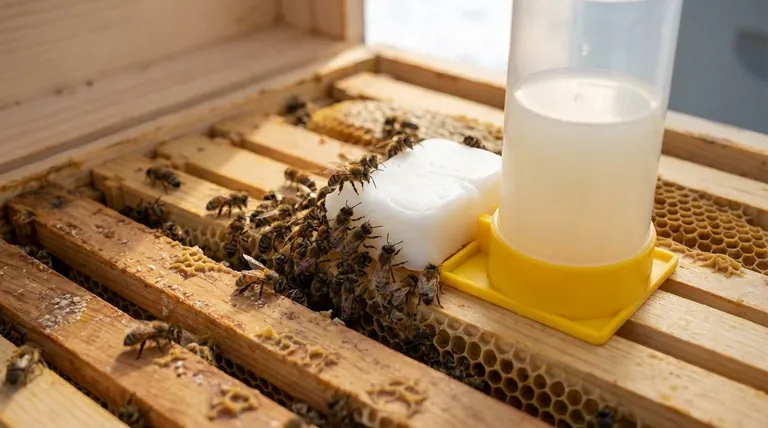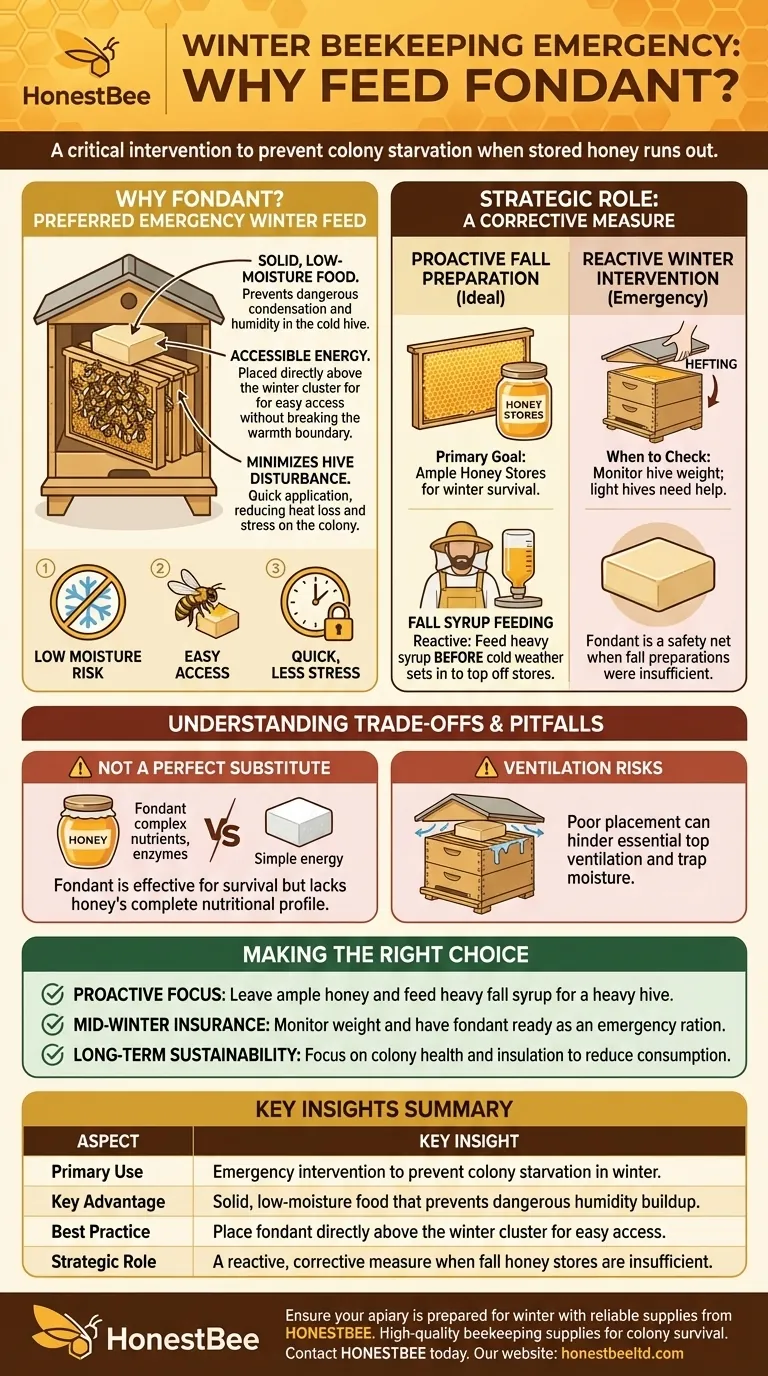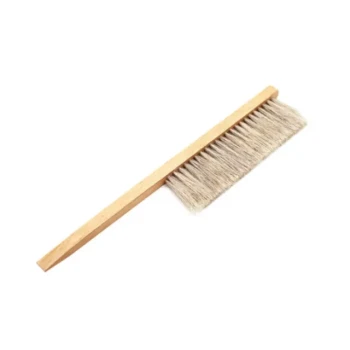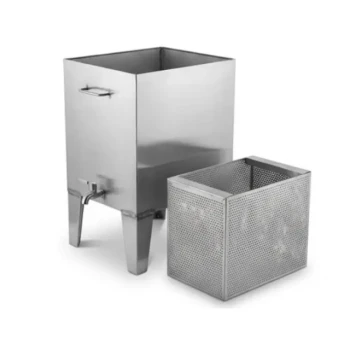Fondant is a beekeeper's emergency intervention used to prevent a honey bee colony from starving during the winter. It serves as a solid, accessible source of carbohydrates when the bees have unexpectedly consumed their stored honey, often due to a longer or colder winter than anticipated.
The core challenge of overwintering bees is ensuring they have enough food to survive until spring. While leaving ample honey is the primary strategy, fondant acts as a critical safety net—a solid sugar brick that provides emergency rations without adding harmful moisture to the hive.

Why Fondant is the Preferred Emergency Winter Feed
The decision to use fondant is based on the unique conditions inside a winter hive. Bees form a tight cluster to stay warm, and introducing liquid feed is often impossible and dangerous.
It's a Solid, Low-Moisture Food
In the cold, liquid sugar syrup would increase the hive's internal humidity. This moisture can condense, freeze, and drip back onto the bees, which can be lethal. Fondant is a solid candy, providing essential sugars with minimal added moisture.
It Provides Accessible Energy
Beekeepers place fondant directly on top of the frames, right above the winter cluster. This allows the bees to access the food without having to break their cluster or expend significant energy moving to a cold corner of the hive.
It Minimizes Hive Disturbance
Applying fondant is a quick process. The beekeeper can open the hive briefly, place the fondant block, and close it back up. This minimizes heat loss and stress on the colony compared to more invasive feeding methods.
Fondant is a Corrective Measure, Not the Primary Plan
Needing to use fondant often indicates that fall preparations were insufficient. The best practice is to ensure the hive is so well-prepared that emergency feeding becomes unnecessary.
The Primary Goal: Ample Honey Stores
The ideal winter food for bees is their own honey. A primary goal of fall management is to leave the colony with a full hive of honey, which provides both carbohydrates and essential micronutrients.
The Role of Fall Syrup Feeding
After the final honey harvest, many beekeepers feed heavy sugar syrup. This is done in the fall before cold weather sets in. The bees process this syrup and store it in the comb, effectively topping off their winter pantry. This is proactive, whereas fondant is reactive.
When to Check for Emergency Feeding
Beekeepers monitor food stores by periodically "hefting" or lifting the hive to gauge its weight. A hive that feels unusually light in mid-winter is a candidate for emergency feeding. On a rare, mild winter day (above 45°F or 7°C), a quick check can confirm if stores are depleted.
Understanding the Trade-offs and Pitfalls
While fondant is a valuable tool, it's essential to understand its limitations and the signals its use provides.
Fondant is Not a Perfect Substitute
Honey contains complex sugars, enzymes, and trace nutrients. Fondant is essentially pure sucrose. It's an effective energy source for survival but lacks the complete nutritional profile of honey.
It Can Signal Insufficient Preparation
Consistently needing to feed fondant may indicate a problem in your fall management strategy. It's a sign to re-evaluate how much honey you leave, the timing and volume of your fall syrup feeding, or the health of the colony going into winter.
Poor Placement Can Hinder Ventilation
Proper winter management includes ensuring the hive has adequate top ventilation to allow moisture to escape. If a fondant block is placed incorrectly, it can seal off this ventilation path, trapping humid air and creating condensation problems.
Making the Right Choice for Your Colony
Your approach to feeding should be dictated by the season and your overall management goals. Using the right tool at the right time is key to ensuring your bees thrive.
- If your primary focus is proactive fall preparation: Leave the bees with ample honey and supplement with heavy sugar syrup after the harvest to ensure the hive is heavy going into winter.
- If your primary focus is mid-winter insurance: Monitor hive weight throughout the winter and have fondant on hand to apply as an emergency ration if the colony feels light.
- If your primary focus is long-term sustainability: Emphasize creating strong, disease-free colonies and providing proper insulation to reduce the bees' overall food consumption, making emergency feeding less likely.
Ultimately, viewing fondant as a crucial emergency tool within a comprehensive winterization strategy empowers you to guide your colonies safely through the harshest months.
Summary Table:
| Aspect | Key Insight |
|---|---|
| Primary Use | Emergency intervention to prevent colony starvation in winter. |
| Key Advantage | Solid, low-moisture food that prevents dangerous humidity buildup. |
| Best Practice | Place fondant directly above the winter cluster for easy access. |
| Strategic Role | A reactive, corrective measure when fall honey stores are insufficient. |
Ensure your apiary is prepared for winter with reliable supplies from HONESTBEE.
As a commercial beekeeper or distributor, having the right equipment and emergency supplies on hand is crucial for colony survival and operational success. HONESTBEE supplies high-quality beekeeping supplies and equipment through wholesale-focused operations, helping you implement effective winterization strategies.
Contact HONESTBEE today to discuss your wholesale needs and ensure your colonies thrive through the coldest months.
Visual Guide

Related Products
- HONESTBEE Professional Entrance Bee Feeder Hive Nutrition Solution
- Professional Insulated Winter Hive Wrap for Beekeeping
- Wooden Bee Brush with Double-Row Horsehair Bristles
- Premium Traditional Copper Bee Smoker with Bellows
- Beekeeper Cowboy Hat and Veil for Beekeeping
People Also Ask
- How to make an entrance feeder for bees? A DIY Guide for Safe & Effective Feeding
- Are entrance feeders good for bees? Prioritize Hive Health Over Convenience
- How is the mesh ladder and barrier installed in the feeder box? A Step-by-Step Guide to Prevent Bee Drowning
- How does a bee entrance feeder work? A Simple Guide to Convenient Hive Feeding
- What is the best feeder for bees? Choose the Right Feeder for Your Hive's Success



















